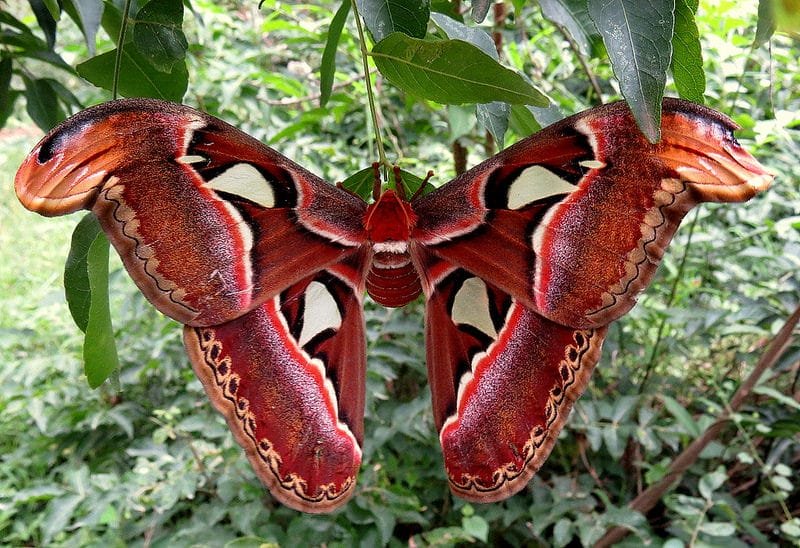
To put it simply, the Atlas Moth isn’t your average butterfly. It makes its home in some of the most lush and tropical areas around the world. When you think of jungles and rainforests, you might picture vibrant green leaves, colorful flowers, and a chorus of animal sounds. That’s exactly where you’ll find this extraordinary moth! In this article, we’ll explore its habitat, diet, and some of the clever ways it has adapted to survive and thrive in its beautiful yet challenging world.
Natural Habitat of the Atlas Moth
When we talk about where the Atlas Moth lives, we’re looking at a few key regions. Primarily, this stunning moth can be found in the tropical and subtropical forests of Southeast Asia. Countries like Indonesia, Malaysia, Thailand, and parts of India are its prime stomping grounds. The Atlas Moth prefers the dense, humid environment of rainforests, where it can easily hide among the leaves and flowers.
These forests aren’t just pretty; they provide everything the Atlas Moth needs to survive. The dense canopy offers shelter from predators, while the rich foliage serves as food sources for caterpillars. Honestly, if you were the Atlas Moth, would you want to live anywhere else? The warm temperatures and consistent humidity in these regions mean that the moths can remain active year-round, unlike species in colder climates that have to hibernate or migrate.
The Lifecycle and Adaptations of the Atlas Moth
Now, let’s talk about the Atlas Moth’s lifecycle, which is just as fascinating as its habitat. The journey begins as an egg laid on the leaves of specific host plants, such as the cashew or guava tree. Once the caterpillar hatches, it faces the critical task of growing while avoiding predators. Here’s the thing: the caterpillar is designed to blend perfectly with its surroundings. Its green and brown coloring mimics the leaves and branches it feeds on, making it harder for birds and other hungry animals to spot.
As the caterpillar matures, it undergoes several molts, increasing its size dramatically. After reaching full size, it forms a chrysalis. The transformation inside is nothing short of miraculous. When it finally emerges as a moth, it’s crucial for its wings to dry and expand. This process can take several hours, during which the moth remains vulnerable. You might be wondering how it protects itself during this stage—one adaptation is its impressive wings, which feature patterns that resemble the eyes of a larger predator, like an owl. This clever visual trick can deter smaller predators.
Feeding Habits of the Atlas Moth
Let’s dive into what the Atlas Moth eats. Adult Atlas Moths don’t feast on nectar like many butterflies. In fact, they don’t eat much at all! Their primary goal is to mate and lay eggs. They do drink fluids from tree sap or rotting fruit, but their life as adults lasts only a few weeks. Think of it as a sprint to reproduce rather than a marathon of survival.
Caterpillars, on the other hand, are voracious eaters. They consume leaves from their host plants, which are rich in nutrients. This diet helps them grow quickly, preparing them for their metamorphosis into moths. It’s interesting to note that their growth phase can last several weeks, showcasing how important their environment is to their survival.
Adaptations for Survival
The Atlas Moth has a few more tricks up its sleeve to stay safe in the wild. Aside from its eye-like wing patterns, it also has the ability to camouflage itself as a dead leaf when it rests. This clever tactic helps it avoid detection from predators like birds and reptiles. When perched on a branch, its shape and coloration make it almost invisible among the foliage.
Another remarkable adaptation is its size. As one of the largest moths in the world, the Atlas Moth benefits from its wingspan. Larger creatures often draw less attention from predators, and its size can be intimidating to smaller threats. Additionally, the moth can glide silently through the forest, making it harder for predators to hear or see it coming. It’s a perfect example of how life has fine-tuned its design over time to thrive in its specific environment.
Conservation Status and Environmental Challenges
Unfortunately, the Atlas Moth faces challenges in today’s world. As large areas of rainforests are cleared for agriculture and development, these magnificent creatures are losing their natural habitat. Deforestation not only limits their living spaces but also affects the plants they rely on for food. Conservation efforts are ongoing in several countries to protect these vital ecosystems, and every little bit helps.
You might be wondering what you can do to contribute. Supporting conservation organizations or spreading awareness about the importance of protecting rainforests can make a difference. It’s about creating a world where future generations can appreciate the beauty and complexity of creatures like the Atlas Moth. We all play a part in the larger web of life, and every action counts.
In Conclusion
The Atlas Moth is a stunning testament to nature’s creativity. Its impressive habitat, unique adaptations, and the delicate balance it maintains within its ecosystem highlight the importance of conservation. As we continue to learn more about this fascinating creature, we’re reminded of how interconnected all life is. Protecting the rainforests not only preserves the Atlas Moth but countless other species that share its home. Let’s work together to ensure these remarkable insects and their habitats continue to thrive for years to come.

